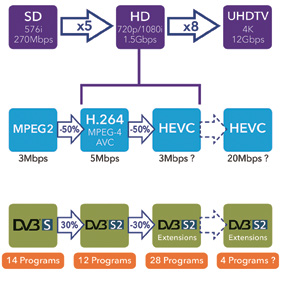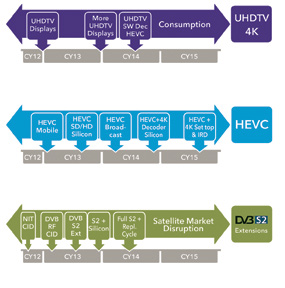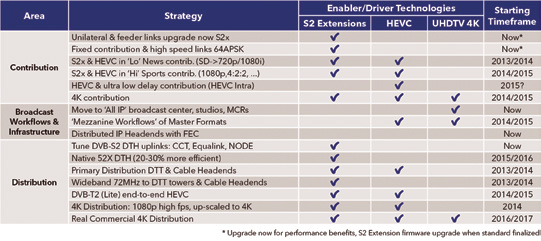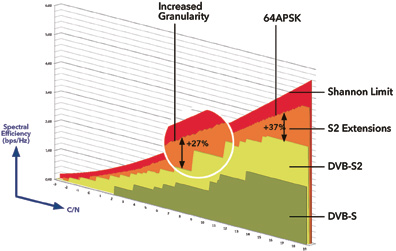There are a number of new broadcasting standards entering the market for quality (UHDTV 4K/8K), compression (HEVC) and satellite transmission (S2 Extensions). They are generating a lot of noise and hype, but underneath, there are real benefits to be gained to the user experience and business of being a broadcaster. They will only be beneficial if they are applied wisely and where they make sense.

This article analyzes the impact of these new standards and technologies and identifies the impact and potential pitfalls, providing strategies and advice on how to benefit from these advances without getting carried away by the hype of the “next big thing.”
Putting UHDTV Into Practical Perspective
The demos of UHDTV are alluring. I was lucky enough to see the London 2012 Olympics demo by NHK in ‘Super Hi-Vision,’ otherwise known as 8K TV with 22.2 surround sound. The demo certainly made my materialistic yearnings say “Ooh, I want one of those.” However, I’ve also been around long enough for my rational side to think “Hey, here we go again, the next installment of SD->HD.”
It is true that manufacturers see UHD as a huge opportunity to drive a replacement sales cycle of TVs, all packed with the latest and greatest 4K resolutions. However, where is the content going to come from? How will it be delivered to those TVs? And, who is going to pay for the content and make money in the process?
Realistically, it seems 4K is liable to become the mainstream UHDTV focus; 8K is just too far away on the horizon. Even in Japan they are looking at 4K for the 2014 FIFA world cup rather than the somewhat daunting 8K. Although 4K needs only four times the bandwidth of Full HD 1080p, most live HDTV is actually broadcast in 720p/1080i. This actually means it is more likely 16 HD channels for each 4K channel with today’s compression technology.
At those large 4K resolutions and screen sizes, high frame rates become extremely important, as well, especially for high value content such as sports. This complicates things significantly and cannot be ignored.
For instance, getting 4K at 50/60fps to the TVs will require HDMI 2.0, which is not even standardized as of this writing. The current HDMI 1.4b only supports 4K to 25/30fps, which is probably not high enough. Indeed, the final distribution ‘market standard’ of 4K is unclear, but is likely driven by compatibility with the TV chipsets.
Recently, there have been some “real 4K over satellite” demos—however, many of these presentations at trade shows continue to use ‘Quad HD’ receivers, which are not identical to the ITU Rec.2020 standard for 2160p 4K.
Then there’s the audio—going beyond 8 channels (for 5.1 or 7.1 surround sound) to something such as 22.2 (MPEG-H 3D) will also require HDMI 2.0, not to mention new home theatre audio systems, as well as new TVs.
For home 4K, the current generation of Blu-ray disks is not sufficient, either, as they would need to store a 200GB movie—new 8-layer disks are under discussion, but they have not arrived yet; so where is the content going to come from?
Further up the live TV production chain, the current mainstream cabling and switching infrastructure is HD-SDI. This 1.5Gbps uncompressed standard is for 720p/1080i HD. The alternative is 3G-SDI, which is required for 1080p operating at 3Gbps. The problem is that, while being increasingly used in new channel/MCR builds, the technology is still quite expensive and there are limitations in component choice and cable distances.
4K will essentially mean the end of broadcast copper and BNC connectors. Moving to 4K will require at least 12Gbps uncompressed or maybe even more, with high frame rates in the 14bit, 120fps range. This implies all OB vans, studios, production, post and asset management will move to a fully IP/Ethernet ICT infrastructure. This is something that is already happening by early adopters, but is far from mainstream today. In fact, many still have to fully make the SD to HD transition.
Even with ICT infrastructure, the current practical limit would be 10GbE, which is not enough for uncompressed 4K, so some ‘light’ compression would be needed even here (so called mezzanine workflows). The 40GbE and 100GbE technologies are for aggregation and core networks, not really LANs. This even ignores workflow impact, such as working with low-res HD proxies in editing and post, but the impact and cost considerations are huge.
Opinions on the likelihood of commercial success of 4K remain divided. Prices of 4K TVs are now in the $7k range and are expected to drop to around $3k by 2014. However, predictions for take-up of 4K capable TVs are only for 4 percent of the U.S. market by 2016 and 15 percent of worldwide markets by 2020.
Others believe the market will simply wait until 8K arrives, skipping 4K all together. What is definitely an emerging trend is the integration of the receiver and CA functionality into the smart TV, with the STB more than likely to disappear in many situations.

Figure 1. TV quality, compression and satellite transmission standards: Past, present and future.
One of the issues with a move to 4K is that this is just the ‘static resolution.’ What is important for adoption of an improved TV standard is the quality of moving images, free from interlacing or jittery temporal interpolation; the ‘dynamic resolution.’ The case for higher frame rates is certainly part of this story, with the argument being that transmitting in 1080p120, and upscaling to 4K in the TV, would offer a better dynamic quality than 4K at low frame rate, and require less bandwidth to transmit.
When and how 4K will happen beyond World Cup and Olympic demos is still debatable. What is certain, though, is that for 4K TV broadcasting capabilities, key considerations such as compression (e.g., HEVC) and transmission (e.g., S2 Extensions on satellite and other fiber and terrestrial efficiency improvements) will be key to making it 4K actually happen.
Saving Bandwidth With MPEG HEVC (H.265)
The promise of sending the same quality TV signal at half the bandwidth is driving great interest in HEVC (High Efficiency Video Coding). The improved processing capacity of the latest devices, thanks to Moore’s Law, allows more sophisticated algorithms to be applied to video, increasing the compression performance. HEVC typically needs 10 times processing capacity in encoders, compared to MPEG-4, AVC, H.264, and three times the capacity in the decoders.
For UHDTV, it is certainly envisaged that to make it feasible to transmit live 4K over satellite, terrestrial and cable, HEVC will be a necessity to reduce throughput to around 20-30Mbps.
However, such is not only for UHDTV. Delivering mobile TV, Internet TV over xDSL, and OTT, are all drivers where the need to preserve bandwidth is key to the business models; increased video traffic will otherwise overwhelm global networks. Indeed, it is for these profiles and SD/HD distribution applications that the initial standard of HEVC was approved in January 2013. However, the increased battery drain in mobile devices, caused by the more complex decoder processing, may well negatively impact adoption of HEVC for Mobile TV/video.
Professional contribution applications (12 bit and higher, 4:2:2/4:4:4 chroma), 3D and support for 4K UHDTV are targeted for completion in a HEVC revision due by January 2014. However, for low latency contribution applications such as stand-up news with talkback and other interactive feeds, HEVC adoption may arrive much later. An example of this is with AVC, where Intra profiles and ultra low delay encoders have only recently entered the market, meaning MPEG-2 is still often used. High compression and low delay is a trade-off.
While HEVC will be an enabler for UHDTV, its adoption will happen much sooner due to the bandwidth savings. Being able to squeeze 720p/1080i HD into 4-5Mbit/s, SD into 1Mbit/s, and upgrade a 720p/1080i HD channels to full HD 1080p, are attractive enough reasons to platform providers, be they satellite or terrestrial in scope.

Figure 2. Likely market timing of S2 Extensions, HEVC and 4K UHDTV
In terrestrial DVB-T2 deployments, HEVC will be quickly used for the primary distribution over satellite to the terrestrial towers, with considerable OPEX savings. Availability of HEVC chipsets in 2013 for consumer DTT receivers will allow the secondary T2 distribution of SD/HD to be in HEVC, as well. The improved business and ROI will make this a ‘no brainer’ in selecting HEVC for ‘green-field’ DTT deployments within a year or two. Similarly, live content distribution to cable head-ends will benefit from these bandwidth savings, with the adoption driven by the business case.
Improved Satellite Efficiency: ‘S2 Extensions’
The efficiency of satellite transmission continues to improve beyond the existing DVB-S2 standards. Currently, extensions and new standards are being specified and tested. For satellite businesses, the creation and adoption of new S2 Extensions will translate into better efficiency, higher speed and improved service robustness. These extensions have the potential for up to 37 percent improvements on top of the current standards. This jumps up to 64 percent or more with 72MHz wideband transponders They are being resolved now in DVB, with the standard due to be released before the end of 2013. Pre-standard efficiency gains are available today, with a firmware upgrade to the final standard.
It is not only for contribution applications and high-speed links, where ‘S2 Extensions’ modulators and demodulators will be installed, gaining maximum improvements. Even for a ‘brown-field’ base of installed Set-Top Boxes (STBs) or IRDs (Integrated Receiver Decoder), tests have shown that some of these extensions (10 or 15 percent roll-offs, advanced pre-distortion) can be deployed today, increasing throughput by as much as 20 percent, or increasing availability to reduce downtime, or expand the service area, without any degradation.
The aforementioned issues of installed base of STBs will limit adoption of native ‘S2 Extensions’ DTH technologies. However, when the receivers become available, higher efficiency gains will be possible at typical DTH operating points.
Timescales For Combining ‘S2 Extensions’, HEVC + UHDTV

Figure 3. Overview of the expected impact of UHDTV/HEVC/S2x
When evaluating strategies for deployment of tomorrow’s ‘S2 Extensions,’ HEVC and UHDTV, it is useful to compare with today’s (DVB-S2/AVC/HD) and yesterday’s (DVB-S/MPEG-2/SD) technologies. They typically entered the market at the same time, being driven by similar factors such as quality when moving from SD to HD, efficiency (DVB-S2, AVC) and cost.
Unfortunately, these different nexgen standards (S2 Extensions, UHDTV, HEVC) will likely enter the market at different times and integrated receiving devices, either professional IRDs or consumer STBs will lag behind until all of the standards are available and are confirmed stable for use. (Please see Figure 2 on the previous page.)
Recommendations for Adoption of UHDTV, HEVC + S2 Extensions
It is clear the three new technologies will make an impact on TV transmission. However, the main goal of this article is to understand which combinations of them will gain market traction, for which applications, and when. An overview of the projected combinations is shown in Figure 3 on the previous page.
Recommendations to benefit from these new S2 Extensions, HEVC + UHDTV, without getting carried away by the hype of the “next best thing,” are as follow:
– You can upgrade existing DTH and other satellite distribution platforms to S2 Extensions today, to get tangible benefits and ROI, with an installed base of STBs.
– You can start using S2 Extensions modulators, receivers and modems now, for contribution and high speed links (higher throughput or less satellite bandwidth), with a software upgrade to the final S2 Extensions in 2013.
– HEVC will make an impact in 2013/2014 in distribution of mobile, SD and HDTV, where the installed base of receivers (e.g., updates for software or FPGA based decoders) does not limit rollout.
– S2 Extensions + HEVC will have a big impact during 2013/2014 in primary distribution of DTT DVB-T2 and to cable head-ends. Most new ‘green field’ DVB-T2 deployments will be looking to use HEVC end-to-end in the 2014/2015 timeframe. Additionally, there will be increased OPEX benefits by using wideband 54 and 72MHz transponders for primary distribution, with increased market adoption.
– Contribution and live feeds using HEVC and S2 Extensions for HD (up to 1080p, 8-14bit, 4:2:0-4:4:4), where longer latency is acceptable, will have an impact in 2014/2015.

Figure 4. Flexible strategies for receivers of S2 Extensions.
– Low latency contribution with HEVC (such as interactive news stand-ups with talk-back) will only really happen in 2015/2016; meanwhile, the latest ultra low latency Intra profile AVC codecs will dominate this market segment.
– HEVC will quickly be used for IP Fast News Gathering (FNG) applications (e.g., over Internet, 3G, VSAT), or for small bitrates for reasonable quality (but longer delays), or for smaller file sizes that will have operational benefits.
– 2014 FIFA World Cup and 2016 Olympics will drive demos of
live 4K UHDTV.
– 4K UHDTV will first be adopted in production, special events and special niches (like super slowmo HD from 4K). Full commercial live 4K TV broadcasting will take considerably longer, but premium content and early adopters will ensure some limited services. Most of the 4K capable TVs will just display up-scaled HD for many years, which, while better than today’s 720p/1080i HD-Lite, may provoke a consumer backlash. Distribution of 1080p HD at high frame rates (with upscaling to 4K in TVs) will be an intermediate step before full 4K distribution becomes technically and economically prevalent.
– 4K will necessitate the adoption of All-IP broadcast infrastructure and mezzanine compression for master formats. This will facilitate distributed broadcast head-ends, which will increase the importance of (ProMPEG COP3) FEC to eliminate packet loss (e.g. between playout and uplink).

S2 Extensions compared, chart courtesy of Newtec.
– Due to difference in market adoption timing of S2 Extensions, HEVC and UHDTV, it is recommended to split professional IRD functionality into separate units (receiver and decoder), to obtain the benefits of the evolutions (especially S2 Extensions + HEVC for SD/HD) in a timely and flexible way—4K will be introduced when the technology is stable and becomes mainstream. This can often be done in a cost-effective way for primary distribution by re-using existing IRDs and using techniques such as transmodulation, shown in Figure 4.
While it is true that a large part of the drive to introduce UHDTV is to sell more TVs, it is not just a gimmick. Advancements in video encoding (HEVC) and satellite transmission (S2 Extensions) will provide tangible cost savings for adoption with today’s TV standards and will be a prerequisite for UHDTV.
As is the case with all new technologies, superior technical performance or features do not guarantee commercial adoption or success. Hopefully, this article has analyzed the real impact and limitations of these new technologies and has attempted to identify what will really happen in the market—and when—and has recommended the winning combinations.
Please visit http://www.newtec.eu for further information.



